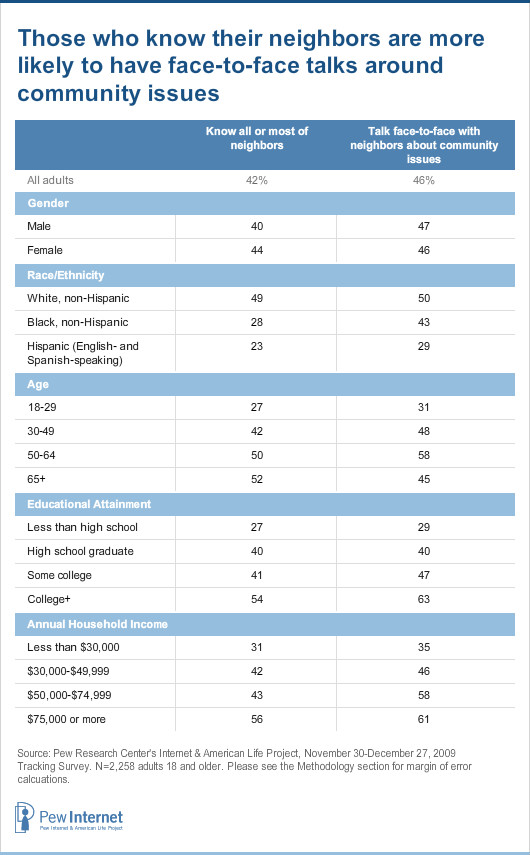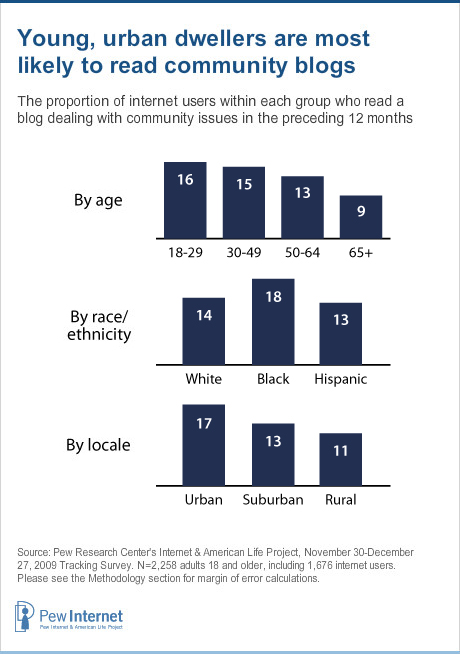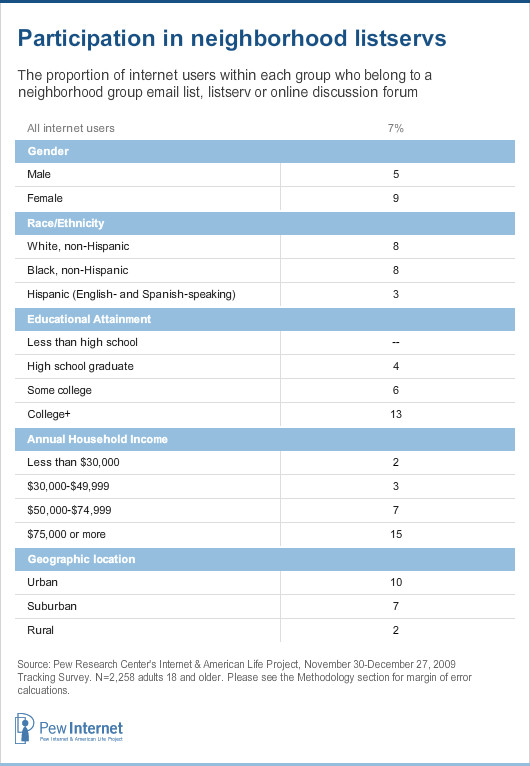How Americans learn about community issues
Overview
Americans use a range of approaches to keep informed about what is happening in their communities and online activities have been added to the mix. Face-to-face encounters and phone calls remain the most frequent methods of interaction with neighbors. At the same time, internet tools are gaining ground in community-oriented communications.
In a poll conducted at the end of last year, we asked about online connections to communities and neighbors and found that in the twelve months preceding our survey:
- 22% of all adults (representing 28% of internet users) signed up to receive alerts about local issues (such as traffic, school events, weather warnings or crime alerts) via email or text messaging.
- 20% of all adults (27% of internet users) used digital tools to talk to their neighbors and keep informed about community issues.
Overall, physical personal encounters remain the primary way people stay informed about community issues. In the twelve months preceding our survey:
- 46% of Americans talked face-to-face with neighbors about community issues
- 21% discussed community issues over the telephone
- 11% read a blog dealing with community issues
- 9% exchanged emails with neighbors about community issues and 5% say they belong to a community email listserv
- 4% communicated with neighbors by text messaging on cell phones
- 4% joined a social network site group connected to community issues
- 2% followed neighbors using Twitter
These findings come from a national telephone survey conducted November 30 to December 27, 2009 among 2,258 Americans (including 565 reached on a cell phone). The margin of error for the full sample is plus or minus 2.4 percentage points. For results based internet users (n=1,676) the margin of sampling error is plus or minus 2.8 percentage points.
Who knows who in neighborhoods and how neighbors interact
We asked our survey respondents whether or not they knew the names of the neighbors who live close to them and found that 19% said that they knew the names of all of their neighbors, and 24% said that they knew most of them.1 The remaining three-fifths of Americans know either some (29%) or none (28%) of their neighbors by name. These figures are unchanged from the last time we asked this question in July 2008. As we have consistently found in previous research, internet use is not correlated with a reduced likelihood of knowing the names of others in one’s neighborhood. Indeed, daily internet users are just as likely as less frequent internet users—and more likely than non-users—to know some or all of their neighbors by name.
Americans use a range of tools to interact with their neighbors and keep up with community events—from face-to-face discussions to local blogs and listservs. These specific approaches are discussed in more detail below.
Face-to-face
When Americans need to find out what is happening in their community, they frequently meet with their neighbors for a face-to-face talk. Nearly half of all the adults we surveyed (46%) had talked face-to-face with their neighbors about community issues in the preceding twelve months, making it the most common activity we measured in this study.
Having face-to-face interactions with neighbors about community developments is tightly linked with factors such as age, socio-economic status and race. Latinos, 18-29 year olds, those without a high school diploma and those with a household income of less than $30,000 per year are among the groups that are least likely to speak to neighbors in person about community issues. These groups are also relatively unlikely to know most or all of their neighbors by name; there is a strong correlation between knowing one’s neighbors and having face-to-face interactions to discuss community issues.

Parents (52%) are more likely than non-parents (43%) to meet with neighbors face-to-face to discuss community issues, and there are no differences on this question based on geographic location—urban, suburban and rural adults are equally likely to have these face-to-face discussions. Additionally, internet users are no less likely than non-users to discuss community issues with their neighbors (indeed, 50% of internet users have done so, compared with 35% of non-users).
Telephone
Talking on the phone about community issues is roughly half as common as talking face-to-face; one in five adults (21%) did this in the last year. By and large, speaking with neighbors about community issues on the phone is common with the same groups that engage in these conversations face-to-face:
- Those ages 50 and older – One quarter (26%) of 50-64 year olds and 29% of those 65 and older talked on the phone with neighbors about community issues in the previous year, significantly higher than the percentage of 18-29 year olds (12%) or 30-49 year olds (19%) who did so.
- College graduates – 28% of those with a college degree did this, significantly higher than all other education levels.
- Non-Hispanics – 23% of whites and 22% of African-Americans had a phone conversation about community issues, compared with 14% of Latinos.
Urban, rural and suburban residents are equally likely to discuss community issues over the telephone, although (in contrast to face-to-face interactions) parents and non-parents are equally likely to speak over the phone about these issues.
Just over one in ten email users (13%, representing 9% of all adults) exchanged email with their neighbors about community issues in the twelve months preceding our survey.2 Neighbor-to-neighbor communications via email are popular with many of the same groups that use face-to-face and telephone interactions:
- College graduates – 21% of online college graduates exchanged email with neighbors about community issues. Among email users who have not graduated college, just 9% have done this.
- Those ages 30 and older – Among email users just 8% of 18-29 year olds exchange emails with neighbors about community issues, compared with 15% of those ages 30-49, 14% of those ages 50-64 and 19% of those 65 and older.
- Parents – 17% of email-using parents and 11% of non-parents have exchanged email with neighbors about issues in their community.
Compared with telephone and in-person communication, racial differences are somewhat less pronounced when it comes to using email to communicate about neighborhood issues. Among email users 15% of whites and 9% of both African-Americans and Hispanics shared email with neighbors about community issues in the preceding year, differences that are not statistically significant. Similarly, there are no significant differences on this question based on geographic location.
Community blogs
Fourteen percent (14%) of internet users – or 11% of all American adults – read a blog dealing with community issues in the twelve months preceding our survey, making community blogs as common as email communications as a way to keep up with neighborhood events. In contrast to face-to-face, telephone and email interactions, neighborhood blogs are relatively popular with young adults: 16% of online 18-29 year olds read a blog dealing with community issues, similar to the rate for those ages 30-64 (15%) and significantly higher than internet users 65 and older (9% of whom have done so).
Community blogs are particularly popular among residents of urban areas, as 17% of wired urbanites read a blog dealing with community issues. This is significantly higher than the 11% online rural residents who read such blogs. Online whites (14%), blacks (18%) and Hispanics (13%) are equally likely to read community blogs, and there is relatively little variation on this question based on income and education.

Text messaging
Nearly 70% of cell phone owners use their mobile devices to send text messages, yet texting is not currently a major tool for neighbor-to-neighbor interactions. Just 6% of these cell texters – or 4% of all American adults – exchanged text messages with neighbors about community issues and events in the twelve months prior to our survey.
Among cell texters there are few major demographic differences on the use of text messaging for community purposes. Interestingly, 10% of African-Americans who use text messaging have texted with others in their neighborhood about community issues; this is among the highest rates of any demographic group, although it is not measurably different from the 6% of white texters who do so.
Rural residents are slightly less likely than those in urban and suburban areas to use the text messaging function on their mobile devices. However, among those who use text messaging rural residents are just as likely to text their neighbors as their urban and suburban counterparts.
Social networking
Nearly one in ten social network users (8%) joined an online group focused on community issues in the preceding twelve months—that works out to 5% of all internet users and 4% of all American adults. Social network users ages 18-29 (9%) and 30-49 (10%) are equally likely to join such groups, while those ages 50 and older (5%) are relatively unlikely to do so. Other than age, there is little variation within the social networking cohort when it comes to using these services to keep up with community events.
Among adults who use Twitter or other status update services, 14% use these sites to follow their neighbors—that works out to 3% of all internet users and 2% of all American adults. There are few demographic differences when it comes to following neighbors on status update services, although for many subgroups the sample size is too small to make detailed comparisons.
Local listservs and email lists
In addition to asking about communications practices, we also asked internet users whether they belong to a group email list, listserv or online discussion forum for their neighborhood. Seven percent (7%) of online adults – or 5% of all American adults – said that they do belong to such a list or forum, a figure that is largely unchanged from the 5% of internet users who responded affirmatively when we last asked this question in July 2008.
Online groups and email lists are especially popular with college graduates and high income-earners. Among internet users, 13% of college graduates belong to this type of online forum (compared with 6% of those with some college experience and 3% of those with a high school degree or less); similarly, 15% of internet users with an annual household income of $75,000 or more belong to an email list or discussion forum, compared with just 2% of those with a household income of $50,000 or less.
Unlike the other ways of keeping up with community events we have discussed thus far, women are more likely than men to belong to online neighborhood groups—9% of online women are part of such a group, compared with 5% of men. There is also some variation around race and ethnicity: among internet users whites (8%) are more likely than Latinos (3%) to belong to such groups (8% of online African-Americans belong to a community forum or email list).
Participation in these groups is also more prominent in urban and suburban areas than in rural parts of the country. Among internet users 10% of urban residents, 7% of suburbanites and just 2% of rural dwellers belong to a neighborhood list.

When it comes to learning about what’s happening in a community, the tools people use are associated with the people they know
Interestingly, the tools people use to keep up with community issues are related to whether or not they are on a first-name basis with their neighbors. As people know fewer of their neighbors by name, they become much less likely to discuss community issues face-to-face. Among those who know all of their neighbors by name, 70% have discussed community issues with neighbors in person, compared with just 12% of those who do not know any of their neighbors. When it comes to using the phone 33% of those who know all of their neighbors by name called someone in the past year to discuss local events, vs. 6% of those who don’t know the names any of their neighbors. The numbers for email are 23% vs. 7%.
On the other hand, individuals who do not know their neighbors by name are just as likely to keep up with community events by reading community blogs (15% of internet users who know none of their immediate neighbors by name read community blogs, identical to the 14% of those who know all of their neighbors who do so) or by joining a community-focused group on an online social network.3


It is also notable that relatively large number of young adults and minority Americans use tools such as community blogs, social networking sites and text messaging to keep up with neighborhood events–especially since these groups are generally less likely than whites and older adults to talk about community issues via the telephone or face-to-face interactions.


